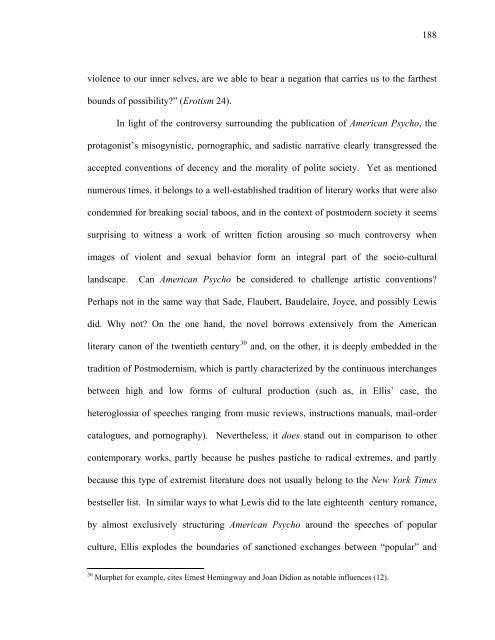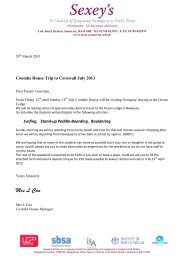Untitled - Sexey's School Moodle
Untitled - Sexey's School Moodle
Untitled - Sexey's School Moodle
Create successful ePaper yourself
Turn your PDF publications into a flip-book with our unique Google optimized e-Paper software.
violence to our inner selves, are we able to bear a negation that carries us to the farthest<br />
bounds of possibility?” (Erotism 24).<br />
188<br />
In light of the controversy surrounding the publication of American Psycho, the<br />
protagonist’s misogynistic, pornographic, and sadistic narrative clearly transgressed the<br />
accepted conventions of decency and the morality of polite society. Yet as mentioned<br />
numerous times, it belongs to a well-established tradition of literary works that were also<br />
condemned for breaking social taboos, and in the context of postmodern society it seems<br />
surprising to witness a work of written fiction arousing so much controversy when<br />
images of violent and sexual behavior form an integral part of the socio-cultural<br />
landscape. Can American Psycho be considered to challenge artistic conventions?<br />
Perhaps not in the same way that Sade, Flaubert, Baudelaire, Joyce, and possibly Lewis<br />
did. Why not? On the one hand, the novel borrows extensively from the American<br />
literary canon of the twentieth century 30 and, on the other, it is deeply embedded in the<br />
tradition of Postmodernism, which is partly characterized by the continuous interchanges<br />
between high and low forms of cultural production (such as, in Ellis’ case, the<br />
heteroglossia of speeches ranging from music reviews, instructions manuals, mail-order<br />
catalogues, and pornography). Nevertheless, it does stand out in comparison to other<br />
contemporary works, partly because he pushes pastiche to radical extremes, and partly<br />
because this type of extremist literature does not usually belong to the New York Times<br />
bestseller list. In similar ways to what Lewis did to the late eighteenth century romance,<br />
by almost exclusively structuring American Psycho around the speeches of popular<br />
culture, Ellis explodes the boundaries of sanctioned exchanges between “popular” and<br />
30 Murphet for example, cites Ernest Hemingway and Joan Didion as notable influences (12).



